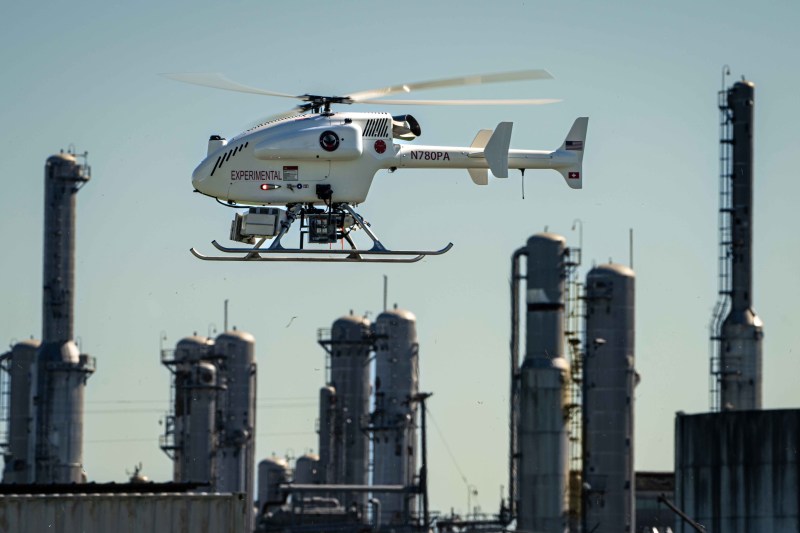The FAA’s long-anticipated BVLOS (beyond visual line of sight) drone rules are edging closer to finalization, than ever. But one major energy company isn’t waiting on the sidelines. Southern Company, the nation’s second-largest energy provider, is now the first U.S. utility to deploy the SDO 50, a heavy-lift unmanned helicopter from Switzerland-based drone maker SwissDrones. Those drones are able to fly for more than three hours — which definitely takes them far beyond BVLOS.
The multi-aircraft deployment marks a major milestone for both companies and signals a turning point for how the American energy sector manages thousands of miles of power lines, pipelines and storm-ravaged infrastructure.
And for the drone industry, it’s interesting news to see such massive aircraft without a human pilot conducting flights this long.
What to know about SwissDrones and its SDO 50 heavy-lift done

For SwissDrones, this deal marks its first hardware contract with a U.S. energy company. It’s also a calculated bet on the American market. Though the SDO 50 is already certified in over 30 countries, it’s only now that SwissDrones is really positioning itself as a go-to solution for BVLOS operations involving large, mission-critical aircraft in the U.S., too.
3+ hour flights over remote terrain
Unlike the smaller quadcopters that have become ubiquitous for spot inspections, the SwissDrones SDO 50 offers a staggering flight endurance of over 3 hours, along with vertical takeoff and landing (VTOL) capabilities and the ability to fly well beyond visual line of sight (BVLOS).
It can carry a heavy payload of advanced sensors including laser methane detectors, high-res RGB/EO/IR cameras and more — making it ideal for pipeline and power line surveillance over rugged, remote environments. This scale of autonomy allows Southern Company to fly the same long-range inspection route weekly.
Why multi-hour flight times matter
The benefit to the company (and its customers)? Generating consistent, comparable data to detect minor anomalies before they snowball into system-wide outages or costly repairs.
“From an increase in extreme weather events to cumbersome inspection practices, companies need new, innovative solutions,” said Ulrich Amberg, CEO of SwissDrones in a prepared statement. “Teaming up with Southern Company will enable more efficient aerial surveillance and inspection to navigate those challenges.”
How much does it cost, and what’s included?

While pricing varies by configuration, the SDO 50’s flexibility and mission-specific integration give it a unique edge in the emerging heavy-UAS sector. Its modular sensor suite includes: laser methane detectors to identify gas leaks with GPS-level accuracy, EO/IR cameras for high-resolution thermal and optical video, AI analysis for post-flight automation of anomaly detection and reporting, and autonomous route repeats to fly the exact same corridor week after week for time-series comparisons.
The drone also integrates with SwissDrones’ Intelligence-as-a-Service platform, allowing clients to bundle hardware with flight crew, monitoring and post-flight data processing.
A strategic launch just ahead of BVLOS reform
This partnership arrives in the wake of President Donald Trump’s Executive Order on BVLOS drone flights. That order, which was signed on June 6, mandates the Federal Aviation Administration (FAA) to finalize rules enabling Beyond Visual Line of Sight (BVLOS) operations for commercial and public safety use.
Once finalized, the rule is expected to dramatically expand legal access for long-range commercial drone operations in U.S. airspace. And when it does, it will unlock a new era of industrial UAV applications like these. And for SwissDrones, it means more potential customers well beyond Southern Company.
The benefits of using heavy-lift drones over long distances

Beyond regulatory timing, this news from Southern Company addresses three key challenges facing modern utilities that affect customers today. Those include:
Climate and reliability: As storm-related outages rise, Southern Company can now conduct faster storm damage assessments and real-time inspections, reducing downtime and improving service reliability.
Emission reduction: The SDO 50 cuts emissions by up to 95% compared to manned helicopters used for the same tasks.
Worker safety: Flying over hazardous or remote areas now requires fewer personnel on the ground or in the air, reducing exposure to risk.
“This technology enhances our ability to gather high-quality data for both electric and gas operations,” said Dean Barefield, UAS program manager at Southern Company in a prepared statement. “It allows us to cover greater distances across our power lines in the Southeast and our natural gas infrastructure throughout our broader service territory.”
The broader trend: infrastructure drones are taking off
Southern Company’s move is not just symbolic — it’s also highly strategic. Utility companies have long used drones for small-scale checks, but BVLOS approval unlocks exponential value. Other new drones on the market, like DJI’s Matrice 400 which launched in June, are also proof of that.
Drones can reduce inspection costs by eliminating manned flights, detect environmental and mechanical degradation earlier, and minimize service downtime and emergency response times. As wildfires, hurricanes and grid demand all intensify, enterprise demand for large autonomous UAVs is booming.
That comes as legislative pressure mounts to limit Chinese drone use — which is posing a headache for big players like DJI. For SwissDrones, it could be an opportunity. After all SwissDrones’ non-Chinese, NATO-aligned platform might be that attractive and compliant alternative for American companies looking to scale without using drones made in China.
With the FAA’s BVLOS rule on the horizon and growing demand for greener, safer and more cost-effective aerial inspection methods, the SwissDrones x Southern Company deployment might be a bellwether for what’s to come.
The post Southern Company becomes first U.S. energy utility to deploy heavy unmanned helicopters for long-range inspections appeared first on The Drone Girl.
